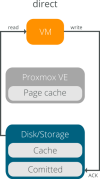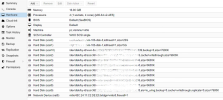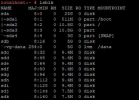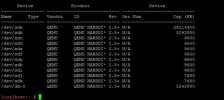Hi Guys.
I have been hunting around the internet for a few days now. I am helping some of our guys with a test Proxmox setup. The issue we have is this. In the symmetrix powermax world. For direct management from a deployed management VM. We need to assign some luns from the storage. Directly. Just like RAW devices in VMware.
This allows us to send our syscalls over the device connection to the arrays and execute commands on the array via our cli solution. We need these devices to be seen as symmetrix. "Vendor" devices so the CLI knows where they come from. We are trying to achive the follwoing layout as that proxmox just passes on the disk as a raw device.

What I should be seeing on the VM side is similar to.
lsblk on working VM host.
NAME MAJ:MIN RM SIZE RO TYPE MOUNTPOINT
sdb 8:16 0 5.6M 0 disk
sdc 8:32 0 5.6M 0 disk
When I list the disks on the VM host I want to be able to see SDB and SDC like the below from my symcli command.
Device Product Device
---------------- --------------------------- ---------------------------
Name Type Vendor ID Rev Ser Num Cap (GB)
---------------- --------------------------- ---------------------------
/dev/sdb GK EMC SYMMETRIX 6079 1XXXXX000 0.0
/dev/sdc GK EMC SYMMETRIX 6079 1XXXXX000 0.0
The VM Configuration is as below.

When we goto the client VM and list the disks "lsblk" we are seeing them as, SDC to SDI

when we then go and try and run an enquiry on the disks we are seeing them as. QEMU Vendor and ID.

We need the disks to be be "ported" for lack of a better word directly to the VM and bypassing the hypervisor.
I have already reiewed
https://pve.proxmox.com/wiki/Passthrough_Physical_Disk_to_Virtual_Machine_(VM)#:~:text=By adding the raw physical,Clonezilla or Ubuntu Rescue Remix.&text=As the disk is attached,on the host can stutter.
https://pve.proxmox.com/wiki/Performance_Tweaks
https://pve.proxmox.com/pve-docs/qm.1.html
I was unable to make the system do what we need after reviewing the above. So I reach out to you super humans in hope that you may be able to point me in the right direction here.
Thank you all so much for all your help and support.
I have been hunting around the internet for a few days now. I am helping some of our guys with a test Proxmox setup. The issue we have is this. In the symmetrix powermax world. For direct management from a deployed management VM. We need to assign some luns from the storage. Directly. Just like RAW devices in VMware.
This allows us to send our syscalls over the device connection to the arrays and execute commands on the array via our cli solution. We need these devices to be seen as symmetrix. "Vendor" devices so the CLI knows where they come from. We are trying to achive the follwoing layout as that proxmox just passes on the disk as a raw device.

What I should be seeing on the VM side is similar to.
lsblk on working VM host.
NAME MAJ:MIN RM SIZE RO TYPE MOUNTPOINT
sdb 8:16 0 5.6M 0 disk
sdc 8:32 0 5.6M 0 disk
When I list the disks on the VM host I want to be able to see SDB and SDC like the below from my symcli command.
Device Product Device
---------------- --------------------------- ---------------------------
Name Type Vendor ID Rev Ser Num Cap (GB)
---------------- --------------------------- ---------------------------
/dev/sdb GK EMC SYMMETRIX 6079 1XXXXX000 0.0
/dev/sdc GK EMC SYMMETRIX 6079 1XXXXX000 0.0
The VM Configuration is as below.

When we goto the client VM and list the disks "lsblk" we are seeing them as, SDC to SDI

when we then go and try and run an enquiry on the disks we are seeing them as. QEMU Vendor and ID.

We need the disks to be be "ported" for lack of a better word directly to the VM and bypassing the hypervisor.
I have already reiewed
https://pve.proxmox.com/wiki/Passthrough_Physical_Disk_to_Virtual_Machine_(VM)#:~:text=By adding the raw physical,Clonezilla or Ubuntu Rescue Remix.&text=As the disk is attached,on the host can stutter.
https://pve.proxmox.com/wiki/Performance_Tweaks
https://pve.proxmox.com/pve-docs/qm.1.html
I was unable to make the system do what we need after reviewing the above. So I reach out to you super humans in hope that you may be able to point me in the right direction here.
Thank you all so much for all your help and support.
Last edited:

